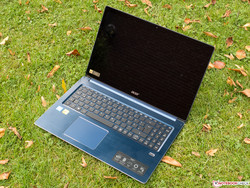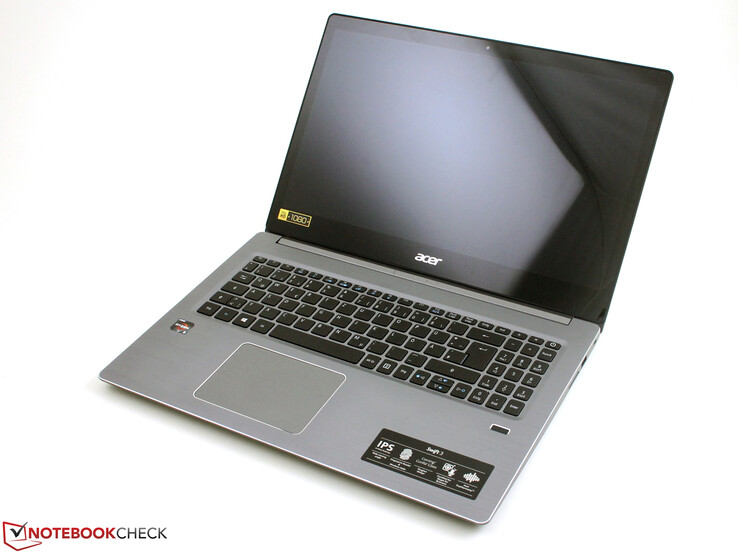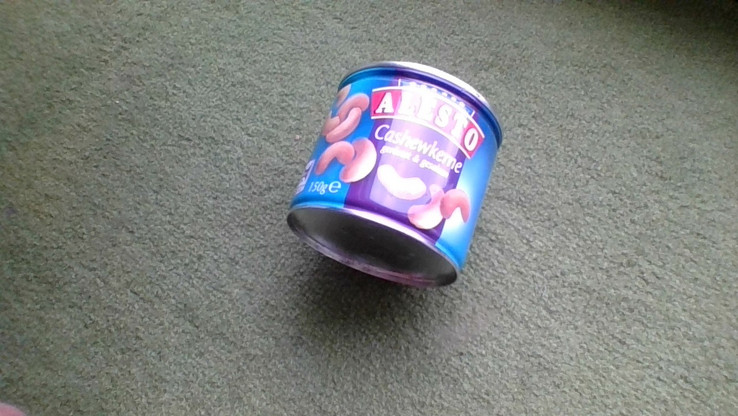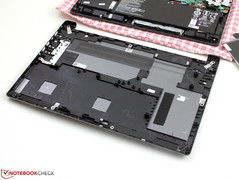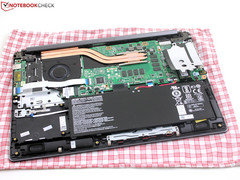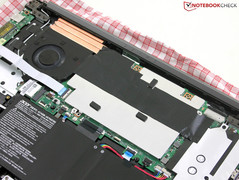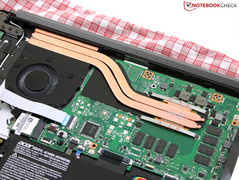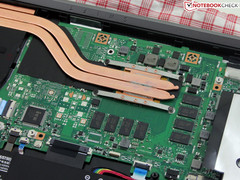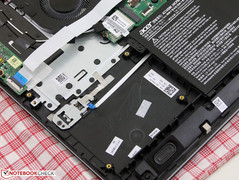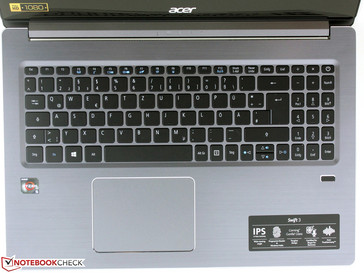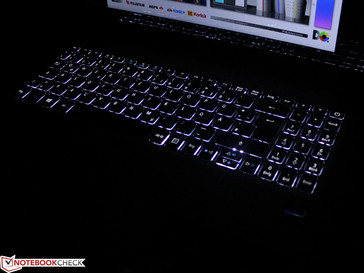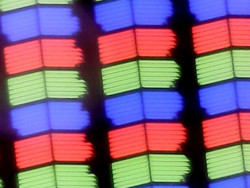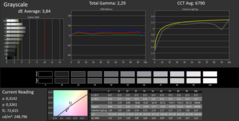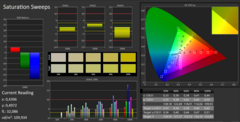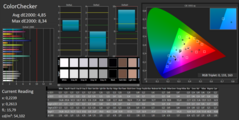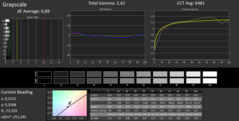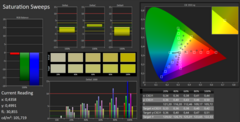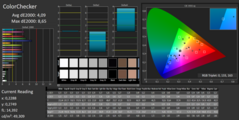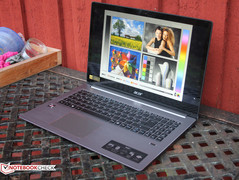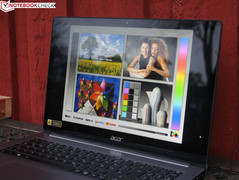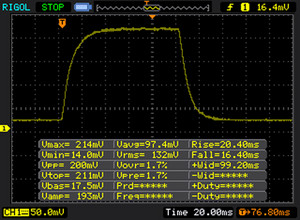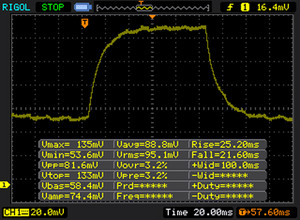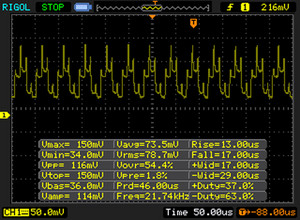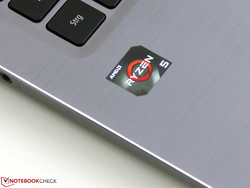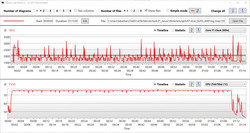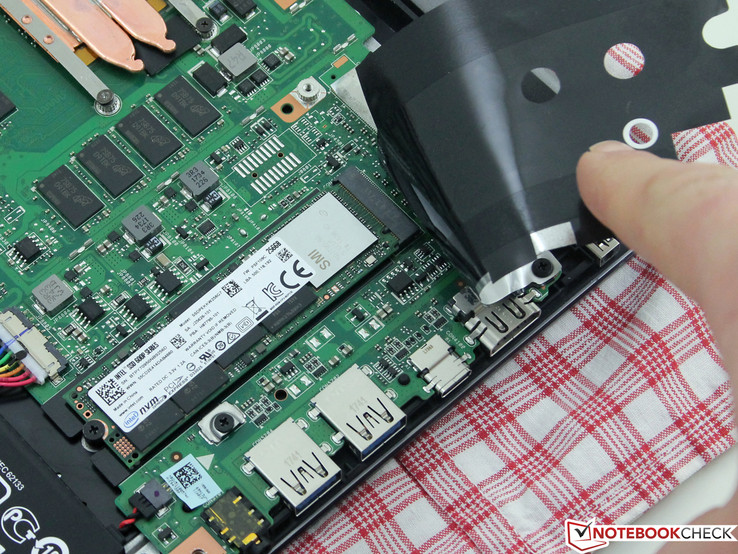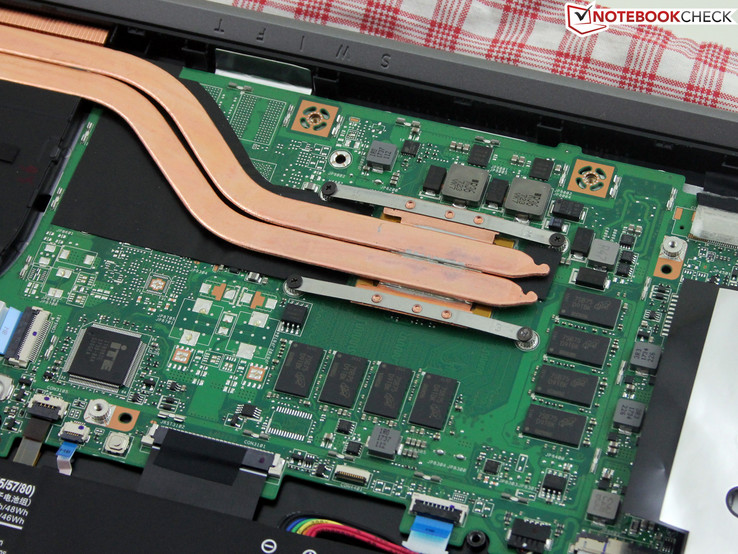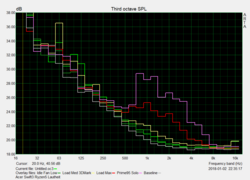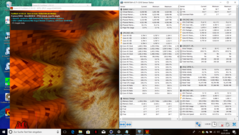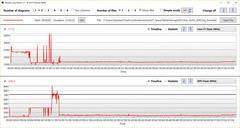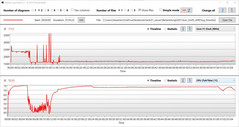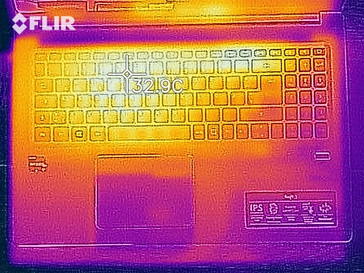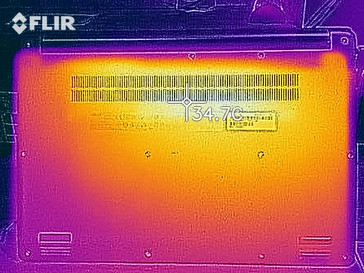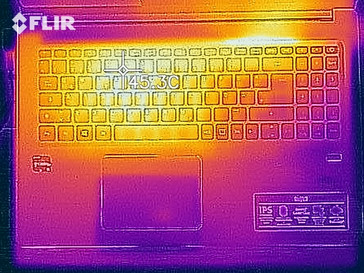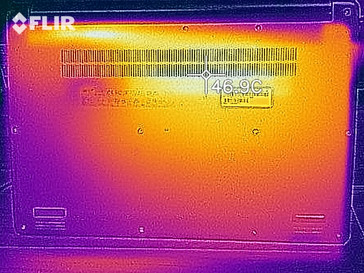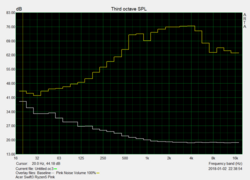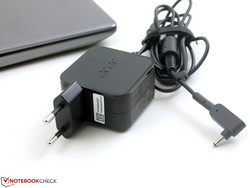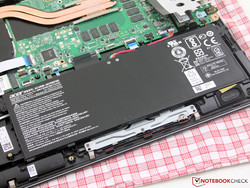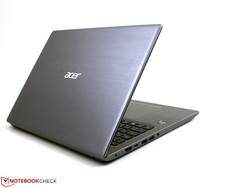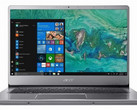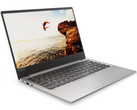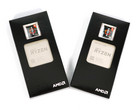Acer Swift 3 SF315 (Ryzen 5 2500U, Vega 8, 256 GB, FHD) Laptop Review

It was not until December 2017 that Acer announced this: The Swift 3 with AMD Ryzen 5 becomes the company's first laptop with the brand-new AMD platform. We immediately became keen of hearing and eagerly watched the shop listings. As soon as Acer said it was available we promptly got our hands on one of the first Swift 3 SF315 devices.
One reason for the excitement: Raven Ridge, Ryzen's mobile platform, had already impressed our US colleagues in the HP Envy x360 15. The convertible had its rough edges and corners, but from a performance point of view it was flawless. Well, almost flawless. The gaming performance was below expectations, yet higher than that of Iris Pro Graphics.
With the HP Envy, we were annoyed by the lack of system performance, which was primarily caused by the mechanical HDD. Now Ryzen may be able to unleash its full potential, as Acer has opted for a 256 GB SSD (PCIe M.2).
The old 15.6-inch Swift 3 SF315 is a friend of ours: Equipped with Intel internals (Kaby Lake Refresh i5-8250U, Nvidia MX150) we tested it in October 2017. The tester liked the low operating noise, the impressive runtime of 8:31 hours in the Wi-Fi test and the compact dimensions.
However, the screen (color space, brightness, response time), the snail-like card reader, the faulty sound system and the missing Thunderbolt 3 were disappointing. Ultimately, the score was 84%. Will this change when Ryzen comes to play? Well yes. The rating drops to 82%. Why this is - and why this has nothing to do with the performance of the SoC - you will find out in this extensive review.
In terms of pricing, the Ryzen 5 Swift 3 is competing with 15-inch models using Intel IGPs. Most of the time, however, we tested the versions with dedicated GPUs. For a performance comparison with the Intel IGP we refer to the Spin 5 SP513 (Intel UHD Graphics 620).
As an additional competitor, we put the latest Intel version of the Swift 3 SF315 (8250U, MX150) in the arena. We also provide other slim 15-inch models with dedicated entry-level GPUs such as the MX150 and 940MX. The HP Spectre x360 15t, which convinced us with its long runtimes, Thunderbolt 3, a bright 4K screen and good input devices, is at the top of the ranking.
| Acer Swift 3 SF315 | HP Spectre x360 15t-bl101 | Acer Aspire 5 A515-51G | Dell Inspiron 15-7570 | |
| CPU | Intel Core i5-8250U | Intel Core i7-8550U | Intel Core i5-7200U | Intel Core i5-8250U |
| GPU | Nvidia GeForce MX150 | Nvidia GeForce MX150 | Nvidia GeForce MX150 | Nvidia GeForce 940 MX |
| Display | 15.6-inch 1,920 x 1,080 | 15.6-inch 4K 3840 x 2160 | 15.6-inch 1,920 x 1,080 | 15.6-inch 1,920 x 1,080 |
| RAM | 8 GB DDR4-2400 | 6 GB DDR4-2400 | 8 GB DDR4-2400 | 8 GB DDR4-2400 |
| Memory | 128 GB | 512 GB | 128 GB | 512 GB |
| Rating | 84 % | 88 % | 83 % | 83 % |
Case
Although Acer uses the same metal casing as the Intel version, the color is steel gray. The upper side of the base and the lid have a brushed metal finish. Fingerprints are left behind much less than on the midnight blue Intel version.
Acer has given the base, touchpad and fingerprint-reader sleek silver edges. In the gray version, however, this is not so obvious. The typical Acer angular hinge and the silver Acer lettering on the back form the visual highlights. Unfortunately, the edge of the base, especially the rounded corners, is characterized by a certain sharp edge.
This does not result in ergonomic disadvantages though. We do not know how Acer did it, but the base of this AMD version is more torsion-resistant and does not produce any cracking noises during pull and back pull. This was the case with the SF315-51G-55Z9.
Due to the lack of space on the lid, the device is somewhat tricky to open. In addition, the lid comes up too if you do not hold against it with your other hand. In return, it does not vibrate during sudden movements. The lid can only be twisted within tight ranges. If you press around on the back of the lid, you will notice image interference at the front.
Compared to the competitors in the test (all 15.6-inch models) the Swift turns out to be the thinnest device. However, the base area is slightly larger and the weight of two kilograms is average for the class. Here, the HP Pavilion 15cc107ng is lighter, but it is thicker than the Swift.
Configuration
Standard USB Type-C, that's all you need to say for the connection. Right-handed users will thank Acer because the only USB 2.0 port, ideal for connecting an external mouse, has ended up in the back right-hand corner. At this location, only the card reader, which swallows approximately 50% of the SD cards, and the Kensington opening are in place. USB 3.0, HDMI and audio can be found at the back of the left side. The positioning of the ports is virtually ideal.
SD Card Reader
We've tested the performance of the card reader with our Toshiba Exceria Pro SDXC 64 GB UHS-II reference SD card. When copying large data blocks the maximum transfer rate is 35 MB/s. This kind of snail-like speed is outdated. Even an internal USB 2.0 connection could have gotten more out of it. Copying image files (about 5 MB each) has a speed of 32 MB/s, which results in long waiting times when copying large amounts of photos to the hard drive. But as the chart shows, most of our competitors are not in a better position.
| SD Card Reader | |
| average JPG Copy Test (av. of 3 runs) | |
| HP Spectre x360 15t-bl100 (Toshiba Exceria Pro SDXC 64 GB UHS-II) | |
| HP Pavilion 15-cc107ng (Toshiba Exceria Pro SDXC 64 GB UHS-II) | |
| Acer Aspire 5 A515-51G-51RL (Toshiba Exceria Pro SDXC 64 GB UHS-II) | |
| Acer Swift 3 SF315-41-R4W1 | |
| Dell Inspiron 15 7570 (Toshiba Exceria Pro SDXC 64 GB UHS-II) | |
| Acer Swift 3 SF315-51G-57E5 (Toshiba Exceria Pro SDXC 64 GB UHS-II) | |
| maximum AS SSD Seq Read Test (1GB) | |
| HP Spectre x360 15t-bl100 (Toshiba Exceria Pro SDXC 64 GB UHS-II) | |
| HP Pavilion 15-cc107ng (Toshiba Exceria Pro SDXC 64 GB UHS-II) | |
| Acer Aspire 5 A515-51G-51RL (Toshiba Exceria Pro SDXC 64 GB UHS-II) | |
| Acer Swift 3 SF315-41-R4W1 | |
| Dell Inspiron 15 7570 (Toshiba Exceria Pro SDXC 64 GB UHS-II) | |
| Acer Swift 3 SF315-51G-57E5 (Toshiba Exceria Pro SDXC 64 GB UHS-II) | |
Communication
Thanks to its MIMO 2x2 module Atheros/Qualcomm QCA6174 with Bluetooth 4.2, the Acer Swift 3 achieves good average IEEE-802.11ac speeds in both transmission and reception (Linksys EA8500, one-meter distance) in the 5 GHz band.
Comparable devices in the test all rely on Intel modules and are more or less on par with each other when it comes to speed. Its good reception quality as a client is positive, and online games or large data transfers in the home network should not be a problem.
Security
A fingerprint-reader on the Swift 3 allows the laptop to be unlocked quickly and reliably via Windows Hello. There is also a Trusted Platform Module (TPM) version 2.0 on board.
Webcam
Unfortunately, the webcam delivers only a poor performance. What's just good enough for Skype is not acceptable for use as a photo. The sensor produces washed-out spots and rough contours in moderate light. This gets much worse when the light is bad, but it is not really better when the light is good.
Accessories
In addition to the tiny 45-watt plug-in power supply unit, the box only contains the usual setup and warranty instructions. Acer does not offer accessories designed specifically for the Swift 3.
Maintenance
At first glance, one might think that maintenance work will be difficult because there is no maintenance hatch and the floor tray is raised to the top of the base. However, anyone who gets past the 12 Torx screws only needs to remove the base plate (without a joint-smoothing trowel or additional tools) to get access to all the internals, including the battery. Unfortunately, the RAM is onboard and there are no RAM banks.
Warranty
Details of Acer's two-year return policy can be found here. The legal dealer's warranty of two years with reversal of the burden of proof after six months applies.
Please see our Guarantees, Return Policies and Warranties FAQ for country-specific information.
Input Devices
Keyboard
The keyboard has a firm base which leads to a hard, sometimes loud impact. Typing on the smooth, flat keys is short-winded. This is due to the short stroke. Lighting is single-level. The pressure point triggers somewhat uncleanly and is not well defined. All this has a detrimental effect on the writing feedback, but it's not as bad as to discourage prolific writers from using these keys.
The slender numeric keypad and the small arrow keys that were pressed under the Shift key are not as good. The fixed wrist-rest does not give way anywhere and is pleasant when writing.
Touchpad
The large ClickPad with the silver edging has a smooth surface that allows even slightly damp fingers to glide smoothly. Accuracy and responsiveness are flawless and even very fast movements are tracked. Drag & drop by double-tap does not cause any problems. Gestures with up to four fingers can be configured with Windows 10 onboard devices.
The very short-stroke replacement mouse buttons convince with their well-tuned resistance and their crisp pressure point with perfect acoustic feedback. Positive: Whether we click on the top or bottom of the pad, the stroke and pressure point are very similar. As usual, however, you have to press a bit harder at the top.
Display
The reflective BOE panel (BOE CQ NV156FHM-N48) is identical to the BOE-TFT of the Intel sister model. Its measured values are quite similar.
To reduce brightness, the panel again uses PWM with a high frequency. Therefore, PWM-related symptoms such as headaches or watery eyes (for sensitive people) should not occur.
The low black level and the not particularly high brightness provide a good contrast of 1,247:1. The effect of bright colors and deep black surfaces is enhanced by the glare type. All Swift 3 devices, whether Intel or AMD-based, are offered with the glare type panel. We only discovered one variant (SF315-51-38U6) with non-glare, which could be an error in the shop description.
| |||||||||||||||||||||||||
Brightness Distribution: 88 %
Center on Battery: 237 cd/m²
Contrast: 1247:1 (Black: 0.19 cd/m²)
ΔE ColorChecker Calman: 4.85 | ∀{0.5-29.43 Ø4.77}
ΔE Greyscale Calman: 3.84 | ∀{0.09-98 Ø5}
58% sRGB (Argyll 1.6.3 3D)
37% AdobeRGB 1998 (Argyll 1.6.3 3D)
40.9% AdobeRGB 1998 (Argyll 3D)
58.5% sRGB (Argyll 3D)
39.59% Display P3 (Argyll 3D)
Gamma: 2.42
CCT: 6790 K
| Acer Swift 3 SF315-41-R4W1 BOE CQ NV156FHM-N48, , 1920x1080, 15.6" | HP Spectre x360 15t-bl100 BOE06C3, , 3840x2160, 15.6" | Acer Aspire 5 A515-51G-51RL AU Optronics B156HAN06.1, , 1920x1080, 15.6" | HP Pavilion 15-cc107ng AU Optronics, , 1920x1080, 15.6" | Dell Inspiron 15 7570 BOE06B4, , 1920x1080, 15.6" | Acer Swift 3 SF315-51G-57E5 BOE NV156FHM-N48, , 1920x1080, 15.6" | |
|---|---|---|---|---|---|---|
| Display | 57% | -3% | -5% | 2% | 1% | |
| Display P3 Coverage (%) | 39.59 | 66.6 68% | 38.3 -3% | 37.28 -6% | 40.43 2% | 39.86 1% |
| sRGB Coverage (%) | 58.5 | 86.9 49% | 57.6 -2% | 56.1 -4% | 60 3% | 58.7 0% |
| AdobeRGB 1998 Coverage (%) | 40.9 | 63.5 55% | 39.57 -3% | 38.51 -6% | 41.77 2% | 41.18 1% |
| Response Times | 14% | 20% | 33% | 5% | 10% | |
| Response Time Grey 50% / Grey 80% * (ms) | 46 ? | 41.2 ? 10% | 41 ? 11% | 45 ? 2% | 45 ? 2% | 42 ? 9% |
| Response Time Black / White * (ms) | 36 ? | 29.6 ? 18% | 26 ? 28% | 13 ? 64% | 33 ? 8% | 32 ? 11% |
| PWM Frequency (Hz) | 21000 ? | 1000 | 996 ? | 21000 ? | ||
| Screen | 11% | 3% | -71% | 9% | -3% | |
| Brightness middle (cd/m²) | 237 | 338.7 43% | 235 -1% | 234 -1% | 255 8% | 248 5% |
| Brightness (cd/m²) | 229 | 325 42% | 236 3% | 230 0% | 240 5% | 237 3% |
| Brightness Distribution (%) | 88 | 91 3% | 80 -9% | 76 -14% | 91 3% | 79 -10% |
| Black Level * (cd/m²) | 0.19 | 0.28 -47% | 0.17 11% | 0.34 -79% | 0.16 16% | 0.21 -11% |
| Contrast (:1) | 1247 | 1210 -3% | 1382 11% | 688 -45% | 1594 28% | 1181 -5% |
| Colorchecker dE 2000 * | 4.85 | 4.9 -1% | 4.69 3% | 12.19 -151% | 4.74 2% | 4.98 -3% |
| Colorchecker dE 2000 max. * | 8.34 | 8.7 -4% | 7.9 5% | 20.81 -150% | 7.68 8% | 8.41 -1% |
| Greyscale dE 2000 * | 3.84 | 5.5 -43% | 3.34 13% | 13.99 -264% | 3.44 10% | 4.26 -11% |
| Gamma | 2.42 91% | 2.08 106% | 2.63 84% | 2.32 95% | 2.43 91% | 2.37 93% |
| CCT | 6790 96% | 7498 87% | 6801 96% | 15863 41% | 7064 92% | 7149 91% |
| Color Space (Percent of AdobeRGB 1998) (%) | 37 | 63.5 72% | 36 -3% | 36 -3% | 38 3% | 38 3% |
| Color Space (Percent of sRGB) (%) | 58 | 86.92 50% | 57 -2% | 56 -3% | 60 3% | 58 0% |
| Total Average (Program / Settings) | 27% /
21% | 7% /
4% | -14% /
-44% | 5% /
7% | 3% /
-1% |
* ... smaller is better
The evenly lit panel results in a value of 88%. Clouding does not occur at the edges. The TFT does not suffer from a blue cast, so the improvements due to our color profile (linked in the box) are marginal. The tight color spectrum cannot be extended anyway. Color accuracy can, at least within a limited color space. Thus, the Swift 3 is not an option for semi-professional image-processing.
The DeltaE score can be reduced to a pleasingly low level of 0.8/4.0 (gray/color) by calibration or the use of our color profile (box). With default settings, the representation at 3.8/4.85 is a little inaccurate but the rivals are not better off.
Display Response Times
| ↔ Response Time Black to White | ||
|---|---|---|
| 36 ms ... rise ↗ and fall ↘ combined | ↗ 20 ms rise | |
| ↘ 16 ms fall | ||
| The screen shows slow response rates in our tests and will be unsatisfactory for gamers. In comparison, all tested devices range from 0.1 (minimum) to 240 (maximum) ms. » 93 % of all devices are better. This means that the measured response time is worse than the average of all tested devices (20.2 ms). | ||
| ↔ Response Time 50% Grey to 80% Grey | ||
| 46 ms ... rise ↗ and fall ↘ combined | ↗ 25 ms rise | |
| ↘ 21 ms fall | ||
| The screen shows slow response rates in our tests and will be unsatisfactory for gamers. In comparison, all tested devices range from 0.165 (minimum) to 636 (maximum) ms. » 78 % of all devices are better. This means that the measured response time is worse than the average of all tested devices (31.6 ms). | ||
Screen Flickering / PWM (Pulse-Width Modulation)
| Screen flickering / PWM detected | 21000 Hz | ≤ 90 % brightness setting | |
The display backlight flickers at 21000 Hz (worst case, e.g., utilizing PWM) Flickering detected at a brightness setting of 90 % and below. There should be no flickering or PWM above this brightness setting. The frequency of 21000 Hz is quite high, so most users sensitive to PWM should not notice any flickering. In comparison: 53 % of all tested devices do not use PWM to dim the display. If PWM was detected, an average of 8083 (minimum: 5 - maximum: 343500) Hz was measured. | |||
Performance
Acer's Swift 3 SF315 is a "bread and butter" machine in the medium price range. The models are available at prices from 650 to 1,200 Euros (~$795 to $1469). For the lowest price you only get an Intel Core i3-7100U but with an IPS FHD and a 128-GB SSD. The maximum configuration comes with a Core i7, 512-GB SSD and GeForce MX150 graphics.
The AMD models are placed in the mid-range. Our gray Swift 3 SF315-41 costs 800 Euros (~$979) and comes with the Ryzen 5 and IGP graphics. The Acer Swift 3 SF315-41G has a Ryzen 7 and a dedicated Radeon RX 540 (2 GB). The latter was not available at the time of the test but we are trying to get our hands on it.
The main memory cannot be expanded or exchanged; Acer has had it soldered directly to the board. Space-saving cannot have been the reason for this in a notebook of this size. Two banks of 4096 MB each are visible on the board. Too bad, because the chipset has 16 GB support.
Processor
The Ryzen 5 2500U is a quad-core processor with a TDP of 15 watts. This qualifies it for slim laptops. In turbo mode the basic clock rate of 2.0 GHz can be driven to 3.6 GHz (single core). In the test we measured a similarly high clock rate that is also maintained for several minutes (R15 single core test, 74 °C).
Acer has set the configurable TDP to 15 watts, as evidenced by HWinfo's analysis during Cinebench and stress tests and the assignment of Intel's 15-watt chips to the same chassis.
The Cinebench loop shows us a fluctuating clock rate of 1.6 to 1.8 GHz in multi-core use. After the best score of 589 points, the score breaks down to 498 points in the following three rounds and builds up to 520 points over a prolonged period of time. As a result, there is a drop of about 13% compared to the first run.
Acer has set the temperature limit at the SoC to 75 °C. The temperature never exceeds 74 °C.
The computing power is convincing regardless of long-term performance. In the single-core test, the R15 is at eye level with the i5-8250U. For the Multi-Test, the Swift 3 with Ryzen 5 even takes the lead. Even the Intel Core i7-8550U has to give in. In the end, however, we are talking about difference of a few percent, which can already be eliminated by a worse thermal implementation in the next test device. So to be safe: The Ryzen 5 2500U runs on the same level as Intel's Kaby-Lake chips, both with single and multi-core load.
System Performance
The Swift 3 with Ryzen 5 cannot score so brilliantly with PCMark 8 and PCMark 10. Here it often takes one of the lowest places with the HP Envy x360 15m (Ryzen 5). Laptops with the MX150 and faster SSDs often get 15 to 100% more points. This is particularly striking in the productivity test of PCMark 10, where the Swift 3 SF315-51G (MX150, 8250U) is far ahead. In the general PCMark 10 score it is still a 52% lead for the Intel version.
| PCMark 8 Home Score Accelerated v2 | 3450 points | |
| PCMark 8 Creative Score Accelerated v2 | 3577 points | |
| PCMark 8 Work Score Accelerated v2 | 3797 points | |
| PCMark 10 Score | 2501 points | |
Help | ||
Storage
Acer uses an Intel M.2-SSD (600p SSDPEKKW256G7, 2280) connected via PCIe 3.0. It is by no means the fastest model and the read 4K rate of 20 MB/s is the worst in the test field. Here, an Intel 750 or a Samsung PM961 would have been the better choice, especially since it is not a limited SATA port.
A hard drive cannot be retrofitted: There is no free connection for this in the chassis. This must be deliberate, because there is not a single Swift 3 SF315 with a hard drive on the market. In theory, the M.2 WLAN module can be replaced by a second M.2-SSD (long design 2280). However, due to the lack of an Ethernet port, no one will want to give the Qualcomm/Atheros chip away voluntarily.
| Acer Swift 3 SF315-41-R4W1 Intel SSD 600p SSDPEKKW256G7 | Acer Swift 3 SF315-51G-57E5 Hynix HFS128G39TND | HP Spectre x360 15t-bl100 Samsung PM961 NVMe MZVLW512HMJP | Acer Aspire 5 A515-51G-51RL Kingston RBUSNS8180DS3128GH | HP Pavilion 15-cc107ng SanDisk SD8SN8U256G1006 | Dell Inspiron 15 7570 Samsung PM961 NVMe MZVLW512HMJP | |
|---|---|---|---|---|---|---|
| CrystalDiskMark 3.0 | -24% | 118% | -33% | -21% | 96% | |
| Read Seq (MB/s) | 1130 | 481.5 -57% | 1248 10% | 407.5 -64% | 475.4 -58% | 2013 78% |
| Write Seq (MB/s) | 601 | 131.5 -78% | 1476 146% | 283.5 -53% | 453.5 -25% | 1015 69% |
| Read 512 (MB/s) | 837 | 324.8 -61% | 849 1% | 282.4 -66% | 345.2 -59% | 1076 29% |
| Write 512 (MB/s) | 606 | 130.6 -78% | 1118 84% | 72.7 -88% | 299.1 -51% | 1038 71% |
| Read 4k (MB/s) | 20.46 | 30.81 51% | 58.8 187% | 26.81 31% | 27.8 36% | 52.1 155% |
| Write 4k (MB/s) | 81.7 | 84.8 4% | 155.2 90% | 73.7 -10% | 54.2 -34% | 135 65% |
| Read 4k QD32 (MB/s) | 235.5 | 345 46% | 645 174% | 294.8 25% | 250.9 7% | 404.2 72% |
| Write 4k QD32 (MB/s) | 155 | 131.6 -15% | 547 253% | 89.6 -42% | 181.8 17% | 510 229% |
Graphics Card
The AMD Radeon RX Vega 8 is integrated into the Raven Ridge chip. It does not have its own graphics memory and supports DirectX-12, which, according to GPU-Z, is 256 MB of DDR4 main memory. The fast dual-channel operation is supported by the card and is also used in the Swift 3. Because it is also a DDR4-2400 memory (Micron 2,400 MHz), maximum power should be extracted from the Vega 8.
| 3DMark 06 1024x768 Score | 12775 points | |
| 3DMark Vantage P Result | 9555 points | |
| 3DMark 11 Performance | 3521 points | |
| 3DMark Ice Storm Standard Score | 60920 points | |
| 3DMark Cloud Gate Standard Score | 10542 points | |
| 3DMark Fire Strike Score | 1928 points | |
Help | ||
Gaming Performance
In the face of real games, the Vega 8 suddenly does not shine any longer. Against the 940MX it can hold its own, but the newer MX150 defeats the Vega. A glance at the sparse green carpet in the table provides an impression. We could not test the setting 1366x768 in some games due to lack of support.
Of course, users can still play with medium resolution/details. Restricted to 1280x720 or even 1600x900, gives BioShock, Dirt Rally and Metal Gear Solid V smooth results in the mid-range and somewhat expands the green carpet.
Current big titles, like Middle-earth: Shadow of War, are less fun. AF and AA have to be turned off completely and a low resolution has to be set. Games which are only a few years old are often playable in medium settings but rarely in the native FHD resolution.
Gaming in Full HD with high details should work with modest titles like Farming Simulator 17 or the FIFA series. We were pleased overall with the down-to-earth gaming power, which was also due to the SSD's fast installation and startup processes.
However, ambitious gamers will not be happy with the integrated Vega 8 and should use the MX150 or, depending on the available budget, the GTX 1050. MX150 multimedia laptops are available in the same price range (800 Euros / ~$979), e.g. the Swift 3 SF315-51G, HP Pavilion 15-ck or the Acer Aspire 5 A515-51G.
Alternatively, there is the Swift 3 SF315-41G with the Ryzen 7 and the Radeon RX 540 (2 GB). We currently cannot evaluate the performance of this dedicated GPU but we're getting our hands on a test sample.
Note: We will evaluate the games shown here extensively within the next few days and will test all current or a few years old games on the Vega 8.
| Rise of the Tomb Raider - 1024x768 Lowest Preset | |
| HP Spectre x360 15t-bl100 | |
| Acer Aspire 5 A515-51G-51RL | |
| HP Envy x360 15m-bq121dx | |
| Acer Swift 3 SF315-41-R4W1 | |
| Dell Inspiron 15 7570 | |
| Deus Ex Mankind Divided - 1280x720 Low Preset AF:1x | |
| Acer Aspire 5 A515-51G-51RL | |
| Acer Swift 3 SF315-41-R4W1 | |
| F1 2017 - 1920x1080 Medium Preset AF:4x | |
| HP Envy x360 15m-bq121dx | |
| Acer Swift 3 SF315-41-R4W1 | |
| Middle-earth: Shadow of War - 1280x720 Lowest Preset | |
| Acer Swift 3 SF315-41-R4W1 | |
| Acer Spin 5 SP513-52N-54SF | |
| BioShock Infinite - 1280x720 Very Low Preset | |
| HP Spectre x360 15t-bl100 | |
| Acer Aspire 5 A515-51G-51RL | |
| Acer Swift 3 SF315-51G-57E5 | |
| HP Envy x360 15m-bq121dx | |
| Acer Swift 3 SF315-41-R4W1 | |
| HP Pavilion 15-cc107ng | |
| Acer Spin 5 SP513-52N-54SF | |
| Metal Gear Solid V - 1920x1080 High / On | |
| HP Envy x360 15m-bq121dx | |
| Acer Swift 3 SF315-41-R4W1 | |
| Acer Spin 5 SP513-52N-54SF | |
| Dirt Rally - 1920x1080 High Preset | |
| Acer Swift 3 SF315-51G-57E5 | |
| Acer Swift 3 SF315-41-R4W1 | |
| Acer Spin 5 SP513-52N-54SF | |
| low | med. | high | ultra | |
|---|---|---|---|---|
| StarCraft 2 (2010) | 183.6 | 68.2 | 47.5 | 30.3 |
| The Elder Scrolls V: Skyrim (2011) | 60 | 49.1 | 35.8 | 21 |
| Diablo III (2012) | 104.9 | 87 | 77.7 | 47.2 |
| Counter-Strike: GO (2012) | 120.7 | 95.8 | 67.3 | 41.9 |
| Tomb Raider (2013) | 122 | 61.1 | 50.3 | 26.8 |
| BioShock Infinite (2013) | 101 | 17.6 | ||
| X-Plane 10.25 (2013) | 40.2 | 22.8 | 10.3 | |
| Sims 4 (2014) | 150 | 57.9 | 31.5 | 27.7 |
| Dragon Age: Inquisition (2014) | 35.6 | 27.5 | 12.8 | |
| GTA V (2015) | 65.5 | 57.8 | 15.7 | |
| Dirt Rally (2015) | 59.1 | 31.4 | 14.7 | |
| The Witcher 3 (2015) | 37.3 | 24 | 12.5 | |
| Metal Gear Solid V (2015) | 59.8 | 20.6 | 16 | |
| Dota 2 Reborn (2015) | 56.2 | 46.8 | 29 | 27.3 |
| World of Warships (2015) | 78.6 | 58.8 | 38.4 | 29.1 |
| Anno 2205 (2015) | 51.3 | 28.1 | 13.2 | 6.2 |
| Rainbow Six Siege (2015) | 82.5 | 52 | 28.3 | 22.4 |
| Rise of the Tomb Raider (2016) | 38.7 | 13.6 | ||
| XCOM 2 (2016) | 31.1 | 10.6 | 7.2 | |
| Far Cry Primal (2016) | 32 | 16 | 14 | |
| The Division (2016) | 40.8 | 26.5 | 19.9 | 8.5 |
| Hitman 2016 (2016) | 25.4 | 26.7 | 17.9 | |
| Deus Ex Mankind Divided (2016) | 25.8 | 11.6 | ||
| Battlefield 1 (2016) | 47.2 | 29.8 | 14.4 | 13 |
| Civilization 6 (2016) | 65.1 | 30.6 | 15.5 | 11.5 |
| Farming Simulator 17 (2016) | 102.5 | 80.3 | 37.3 | 15.6 |
| Titanfall 2 (2016) | 65.1 | 46.9 | 17.5 | 15.7 |
| Resident Evil 7 (2017) | 67.6 | 27.8 | 17.3 | 11.2 |
| For Honor (2017) | 49 | 17.6 | 17 | 13.4 |
| Rocket League (2017) | 99.7 | 42.7 | 28.2 | |
| Team Fortress 2 (2017) | 67.3 | 63.4 | 50.5 | 37.5 |
| Playerunknown's Battlegrounds (PUBG) (2017) | 33 | 14 | 12.3 | |
| F1 2017 (2017) | 50 | 23 | 23 | |
| Ark Survival Evolved (2017) | 21.8 | 6.8 | ||
| FIFA 18 (2017) | 125.9 | 69.8 | 57.3 | 53.4 |
| Middle-earth: Shadow of War (2017) | 33 | 14 | 10 | |
| The Evil Within 2 (2017) | 17.7 | 9.9 | 8.9 | |
| Destiny 2 (2017) | 41.2 | 23.5 | 21 | 18.2 |
| Assassin´s Creed Origins (2017) | 12 | |||
| Call of Duty WWII (2017) | 61.4 | 56.1 | 18 | |
| Need for Speed Payback (2017) | 30.6 | 16.3 | 12.8 | |
| Star Wars Battlefront 2 (2017) | 33.7 | 10.3 | 9.3 |
Emissions
System Noise
Our Swift 3 rarely switches off its fan when it is idling. The energy mode is irrelevant, since Acer only installs one balanced profile as default. When used in offices for web-surfing with plenty of pauses to think, the single fan purrs with 32.3 dB(A). This is audible, but it is so smooth that it does not disturb.
However, more is also possible in three stages of 33, 35 and just under 38 dB(A). The former is a simple load by a 3DMark run. When playing, this quiet fan will probably suffice. If you challenge the processor cores to the fullest extent, the noise will become much more noticeable. The system reduces the clock rate of the CPU and GPU cores in the stress test, which is why only 34.8 dB(A) is achieved here.
Noise level
| Idle |
| 31.8 / 32.1 / 32.1 dB(A) |
| Load |
| 33 / 34.8 dB(A) |
 | ||
30 dB silent 40 dB(A) audible 50 dB(A) loud |
||
min: | ||
Temperature
The system protects itself from overheating beyond 75 °C during the stress test and reduces the clock rate to 1.66 GHz or 230 MHz (Vega 8). This ensures low energy absorption of 42 watts. Prime95 by itself starts with 45 watts, i.e. the full load of the 45-watt power supply. The battery is not discharged and there is no obvious deficit. The power supply, however, heats up to 61 °C.
Due to the strict limitation, the surfaces always remain pleasantly tempered. 41 °C was not exceeded at the top or bottom during the stress test.
(±) The maximum temperature on the upper side is 41 °C / 106 F, compared to the average of 36.9 °C / 98 F, ranging from 21.1 to 71 °C for the class Multimedia.
(±) The bottom heats up to a maximum of 41.1 °C / 106 F, compared to the average of 39.2 °C / 103 F
(+) In idle usage, the average temperature for the upper side is 27.7 °C / 82 F, compared to the device average of 31.3 °C / 88 F.
(±) The palmrests and touchpad can get very hot to the touch with a maximum of 37.3 °C / 99.1 F.
(-) The average temperature of the palmrest area of similar devices was 28.7 °C / 83.7 F (-8.6 °C / -15.4 F).
Speakers
The loudspeakers only reproduce a thin, mid-range spectrum. Basses or balanced highs are lost. The speakers are located at the front under the palm rest.
The voice-recording capability of the Swift 3 is quite good: no noise, no metallic distortion and no distorted voice. A speaker can stand directly in front of the Swift or walk around the room turned away from the laptop.
Acer Swift 3 SF315-41-R4W1 audio analysis
(±) | speaker loudness is average but good (76 dB)
Bass 100 - 315 Hz
(±) | reduced bass - on average 13.2% lower than median
(+) | bass is linear (4.5% delta to prev. frequency)
Mids 400 - 2000 Hz
(±) | higher mids - on average 6.1% higher than median
(+) | mids are linear (6.5% delta to prev. frequency)
Highs 2 - 16 kHz
(±) | higher highs - on average 6.4% higher than median
(+) | highs are linear (4.9% delta to prev. frequency)
Overall 100 - 16.000 Hz
(±) | linearity of overall sound is average (17.3% difference to median)
Compared to same class
» 47% of all tested devices in this class were better, 8% similar, 45% worse
» The best had a delta of 5%, average was 17%, worst was 45%
Compared to all devices tested
» 32% of all tested devices were better, 8% similar, 60% worse
» The best had a delta of 4%, average was 24%, worst was 134%
Dell Inspiron 15 7570 audio analysis
(-) | not very loud speakers (67.4 dB)
Bass 100 - 315 Hz
(-) | nearly no bass - on average 18.2% lower than median
(±) | linearity of bass is average (13.1% delta to prev. frequency)
Mids 400 - 2000 Hz
(+) | balanced mids - only 3.5% away from median
(±) | linearity of mids is average (8.1% delta to prev. frequency)
Highs 2 - 16 kHz
(+) | balanced highs - only 2.3% away from median
(±) | linearity of highs is average (9.9% delta to prev. frequency)
Overall 100 - 16.000 Hz
(±) | linearity of overall sound is average (20.8% difference to median)
Compared to same class
» 47% of all tested devices in this class were better, 9% similar, 43% worse
» The best had a delta of 7%, average was 21%, worst was 53%
Compared to all devices tested
» 56% of all tested devices were better, 8% similar, 37% worse
» The best had a delta of 4%, average was 24%, worst was 134%
Frequency diagram in comparison (checkboxes can be turned on/off!)
Energy Management
Power Consumption
The above-average energy consumption in idle mode is remarkable in all three states. 10.8 watts is consumed without key illumination, 13 watts with the included light. The other test devices were - if available - also measured with key illumination. A Swift 3 with Intel requires 35-40% less energy on average in idle mode, which is why the runtime in the Wi-Fi test is considerably better.
On the other hand, the Ryzen device is very economical when compared to laptops with dedicated GPUs. Under load, laptops with Intel IGP are even more economical though (30-35 watts, Acer Spin 5).
| Off / Standby | |
| Idle | |
| Load |
|
Key:
min: | |
| Acer Swift 3 SF315-41-R4W1 R5 2500U, Vega 8, Intel SSD 600p SSDPEKKW256G7, IPS, 1920x1080, 15.6" | HP Envy x360 15m-bq121dx R5 2500U, Vega 8, HGST Travelstar 7K1000 HTS721010A9E630, IPS, 1920x1080, 15.6" | Acer Swift 3 SF315-51G-57E5 i5-8250U, GeForce MX150, Hynix HFS128G39TND, IPS, 1920x1080, 15.6" | HP Spectre x360 15t-bl100 i5-8550U, GeForce MX150, Samsung PM961 NVMe MZVLW512HMJP, IPS, 3840x2160, 15.6" | Acer Aspire 5 A515-51G-51RL i5-7200U, GeForce MX150, Kingston RBUSNS8180DS3128GH, IPS, 1920x1080, 15.6" | HP Pavilion 15-cc107ng i5-8250U, GeForce 940MX, SanDisk SD8SN8U256G1006, TN LED, 1920x1080, 15.6" | Dell Inspiron 15 7570 i5-8550U, GeForce 940MX, Samsung PM961 NVMe MZVLW512HMJP, IPS, 1920x1080, 15.6" | Acer Spin 5 SP513-52N-54SF i5-8250U, UHD Graphics 620, Micron 1100 MTFDDAV256TBN, IPS, 1920x1080, 13.3" | |
|---|---|---|---|---|---|---|---|---|
| Power Consumption | 4% | 9% | -52% | 12% | 15% | 6% | 30% | |
| Idle Minimum * (Watt) | 7.3 | 5.9 19% | 3.8 48% | 11.6 -59% | 2.9 60% | 2.8 62% | 3.6 51% | 3.9 47% |
| Idle Average * (Watt) | 9.7 | 8.7 10% | 6.5 33% | 13.8 -42% | 5.9 39% | 5.8 40% | 6.7 31% | 8.2 15% |
| Idle Maximum * (Watt) | 13 | 10.5 19% | 9.1 30% | 14.2 -9% | 6.4 51% | 7.5 42% | 9.2 29% | 8.8 32% |
| Load Average * (Watt) | 40.4 | 45.7 -13% | 53.4 -32% | 67.9 -68% | 54 -34% | 54 -34% | 59 -46% | 28.5 29% |
| Load Maximum * (Watt) | 42.2 | 49.4 -17% | 55.6 -32% | 76.9 -82% | 66 -56% | 56 -33% | 58 -37% | 30.7 27% |
| Witcher 3 ultra * (Watt) | 45.8 | 59 | 51 |
* ... smaller is better
Battery Life
By reducing the production process from 28 nm to 14 nm and including further efficiency improvements, the runtime of Raven Ridge is expected to be significantly longer than that of Bristol Ridge. Acer's 48 watt-hours makes a good specification. It's almost the same capacity as the Intel model.
Nevertheless, the Acer Swift 3 SF315-51G (Intel) lasts three hours longer in operation when not plugged in. The gathered Intel competition is more efficient as far as runtime is concerned, whether in idle, Wi-Fi or load testing. This matches the HP Envy x360 15m (Ryzen 5), which lasts only 1.5 hours longer with 8 watt-hours more (Wi-Fi test).
| Acer Swift 3 SF315-41-R4W1 R5 2500U, Vega 8, 48 Wh | Acer Swift 3 SF315-51G-57E5 i5-8250U, GeForce MX150, 49.7 Wh | HP Envy x360 15m-bq121dx R5 2500U, Vega 8, 55.8 Wh | HP Spectre x360 15t-bl100 i5-8550U, GeForce MX150, 79.2 Wh | Acer Aspire 5 A515-51G-51RL i5-7200U, GeForce MX150, 48 Wh | HP Pavilion 15-cc107ng i5-8250U, GeForce 940MX, 41.7 Wh | Dell Inspiron 15 7570 i5-8550U, GeForce 940MX, 42 Wh | Acer Spin 5 SP513-52N-54SF i5-8250U, UHD Graphics 620, 53.9 Wh | |
|---|---|---|---|---|---|---|---|---|
| Battery runtime | 63% | 3% | 52% | 69% | 27% | -44% | 60% | |
| Reader / Idle (h) | 12.2 | 10.9 -11% | 15.6 28% | 20.9 71% | 4.7 -61% | |||
| WiFi v1.3 (h) | 5.2 | 8.5 63% | 6.6 27% | 8.5 63% | 8.6 65% | 6.6 27% | 1.8 -65% | 8.3 60% |
| Load (h) | 1.4 | 1.3 -7% | 2.3 64% | 2.4 71% | 1.3 -7% | |||
| H.264 (h) | 8.2 | 4 |
Verdict
Pros
Cons
With Ryzen 5 Mobile, AMD clearly sees itself ahead of Intel's Kaby Lake Refresh chips, a statement that we can agree with if we remove "clearly" from it. In the case of the 2500U, the general computing power is at eye level with the Core i5-8250U or just below the Core i7-8550U. In Multi-Core, Ryzen 5 seems to have an advantage (+5%), but this high Cinebench score cannot be maintained at permanent performance. Let's be fair though: Many Intel devices show such a turbo drop too. How long the turbo is fully powered up still depends heavily on the manufacturer's implementation (capacity of the cooling system).
In recent years, AMD implementations have very often suffered from poor accompanying hardware, most recently Bristol Ridge. In order to meet the price level, bad TN panels, HDD memory, single-channel RAM or slow WLAN chips were used. As a whole, a pile of misery was left behind, which in addition was clearly weaker than the Intel alternatives.
With the Swift 3 SF315-41-R4W1, Acer does not make such major mistakes - at least not as many. The 15-incher has fast DDR4 memory (dual-channel enabled), a good WLAN module (2x2 AC, BT 4.2) and it offers a balanced display (colors calibrated) as well as proper input devices. The Ryzen 5 can furthermore keep up with current Skylake and Skylake refresh hardware, while the Vega 8 graphics card is faster than an Intel UHD Graphics 620 (Skylake Refresh).
Overall, the device is appropriately priced at 800 Euros (~$979) and we can give a limited recommendation to buy. Real drawbacks are the slow Intel SSD, which apparently spoils the PCMark scores, and the weak runtimes (5 hours instead of 8 hours), caused by high idle energy consumption.
The Radeon Vega 8 will only satisfy gamers to a limited extent (940MX standard). It remains to be seen how the Radeon RX 540 (2 GB) will perform in the near future. If it performs well above an MX150, then the price of just under 1,000 Euros (~$1224) for its sister model with Ryzen 7 (Swift 3 SF315-41G) would also be justified.
Acer Swift 3 SF315-41-R4W1
- 01/06/2018 v6 (old)
Sebastian Jentsch


